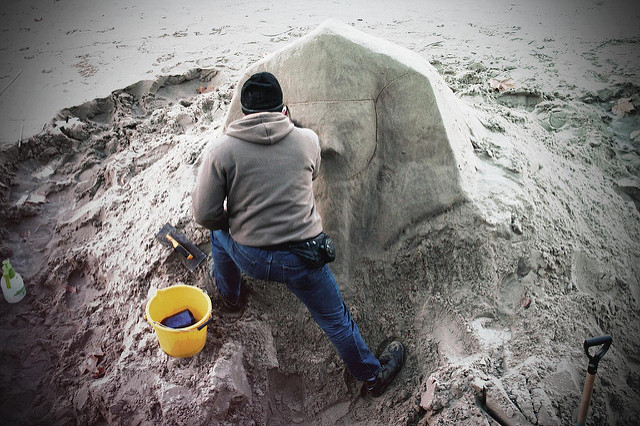Unlock the Magic in Your Story Now
Get the Free 20 questions to Ask Before Launching Your Idea workbook when you sign up for occasional updates.
Get the Free 20 questions to Ask Before Launching Your Idea workbook when you sign up for occasional updates.
Articles filed in: Strategy
Another Time
 During a high-intensity workout, the trainer reminds the athlete to treat every set as if it were the last. To train as if this was the only sixty seconds, he would cycle that day. In that moment, with that mindset he increases his effort, his performance intensifies and that changes his results.
During a high-intensity workout, the trainer reminds the athlete to treat every set as if it were the last. To train as if this was the only sixty seconds, he would cycle that day. In that moment, with that mindset he increases his effort, his performance intensifies and that changes his results.
We often presume we will have time to do something over. That there will be another time to do our best work. Next time we’ll make more effort or do it better. What’s stopping us from doing it the best way we know how this time? If it’s worth doing why not act as if there won’t be another time?
It turns out that our results are determined by the little things we chose not to do each and every time, more than by the big thing we once did.
Image by Will
The Slow And Steady Advantage
 The salespeople at our local gym usually interact with their customers once. A person who is motivated enough to book a gym tour, followed by the inevitable sales conversation is likely to join. The conversion rate is high. While designing the experience to optimise the quickest route to the sale works for the gym—it’s not a good model for most businesses.
The salespeople at our local gym usually interact with their customers once. A person who is motivated enough to book a gym tour, followed by the inevitable sales conversation is likely to join. The conversion rate is high. While designing the experience to optimise the quickest route to the sale works for the gym—it’s not a good model for most businesses.
Most businesses are sustained by multiple interactions with returning customers over time. Consistent engagement over time adds value, even when it doesn’t end in a sale.
Trust is an invaluable resource.
In our hurry to succeed we sometimes overlook the opportunity to engage first and sell later. Marketing works best when it’s anticipated, and the person on the other side of the interaction feels like they had a hand in the result.
Business is a marathon, not a sprint.
Image by Sue Langford
People Power
filed in Marketing, Storytelling, Strategy
 When a traveller books a $700 a night hotel room she assumes that she’ll have a five-star experience. She’s expecting more than a better bed, thicker carpets and fancier facilities. When a five-star hotel gets a one-star review, it’s an indication that something went badly wrong.
When a traveller books a $700 a night hotel room she assumes that she’ll have a five-star experience. She’s expecting more than a better bed, thicker carpets and fancier facilities. When a five-star hotel gets a one-star review, it’s an indication that something went badly wrong.
Of course, guests and customers are disappointed for a variety of reasons. Reality can’t always meet expectations. Sometimes the room is noisy, or the food is cold. Maybe the shower is dirty, or the bed is uncomfortable. But these issues in isolation rarely result in a ‘terrible’ review.
When you analyse one-star reviews, a clear pattern emerges. It doesn’t matter whether the hotel’s room rate is $700 or $70 a night—every single one-star review is a result of human failure. It’s what happens in the moment when the customer seeks acknowledgement that changes everything.
The best product on the planet is rendered virtually worthless if the person delivering it fails to make a human connection with the customer. We want to be seen more than we want plush carpets beneath our feet or goose down pillows under our heads.
Image by Thomas Hawk
To Do Or Not To Do
 We wake every day with solid ideas and imperfect plans.
We wake every day with solid ideas and imperfect plans.
And yet every day we stall.
We blame time.
We await readiness or motivation, or both.
We rationalise about tomorrow being better.
We make assumptions about what it takes to be good enough.
We allow doubt and uncertainty to take hold.
We wait. Forgetting that every unrealised opportunity hinged on the thing we decided not to do.
We must commit to acting when we can, while we can, because we can.
Image by Jon Nicholls
Forget Which Way The Wind Is Blowing
 When the disco diner opened on a warm Summer night in a flurry of pink neon, accompanied by loud music and cheap booze, the owner felt reassured he’d found his tribe. But as the evenings grew shorter and the nights colder, his confidence began to waver. The evolving messaging on a pair of sandwich boards obstructing the pavement outside was a sign that all was not well inside.
When the disco diner opened on a warm Summer night in a flurry of pink neon, accompanied by loud music and cheap booze, the owner felt reassured he’d found his tribe. But as the evenings grew shorter and the nights colder, his confidence began to waver. The evolving messaging on a pair of sandwich boards obstructing the pavement outside was a sign that all was not well inside.
The first board advertised the diner’s happy hour—$5 beers, wine and schooners from 4-7pm. The second advised that the kitchen was vegan-friendly and open until 1 am. An attempt to pick up customers who couldn’t get a table at the popular vegan taco place across the street.
The wind had clearly changed direction. Successful businesses don’t alter their marketing strategy according to which way the wind is blowing. They know who they are and who they’re for. They know what they’re good at and have a plan to be great at it. Successful brands don’t haphazardly take up the slack. They intentionally set out to do something worthy of becoming the chosen one.
Image by P. Monaghan
Skill Vs. Talent
filed in Storytelling, Strategy
 The dentist looks inside the patient’s mouth. She completes her examination, makes an assessment and proposes treatment. The proposed treatment considers only two things. What’s going on inside the patient’s mouth and his ability to pay.
The dentist looks inside the patient’s mouth. She completes her examination, makes an assessment and proposes treatment. The proposed treatment considers only two things. What’s going on inside the patient’s mouth and his ability to pay.
The dentist knows she can fix the problem. She wants to do a good job. This is the work she’s trained for twenty years to do. But her training hasn’t equipped her to see that treatment isn’t only about executing flawless fillings. A good dentist assesses the mouth, then fills the tooth to relieve the pain. A great dentist looks the patient in the eye and understands why he’s worried about having a broken tooth before she thinks about drilling.
Proficiency and competence are a given. What patients, clients and customers want is someone who has the talent to see their problems in context. A professional who knows that they are more than the sum of their challenges and the contents of the wallets.
Image by My Future.
The Rise Of The Patient Marketer
 The fact that we’re exposed to thousands of marketing messages every day is old news. Our lives are now designed to mitigate against being interrupted by things we don’t care about and never respond to. And yet, we often fail to acknowledge that the people we want to reach feel the same way. If we’re not in the market for having someone steal our limited time and attention, we can’t expect our prospective customers to be. They’re fast-forwarding, ad blocking, spam filtering, deleting and ignoring what’s irrelevant to them without giving it a second thought.
The fact that we’re exposed to thousands of marketing messages every day is old news. Our lives are now designed to mitigate against being interrupted by things we don’t care about and never respond to. And yet, we often fail to acknowledge that the people we want to reach feel the same way. If we’re not in the market for having someone steal our limited time and attention, we can’t expect our prospective customers to be. They’re fast-forwarding, ad blocking, spam filtering, deleting and ignoring what’s irrelevant to them without giving it a second thought.
The good news is that the people who win in the attention deficit age are the patient marketers. The people who thoughtfully provide value. The companies that are deeply invested in creating lasting change and delivering as well as experiencing joy along the way. The marketers who are not interested in hustling their way to quick wins. The founders who are in business for the long haul.
You no longer have to worry about being the loudest, most visible, best-resourced business.
You’ve got time to take the long way round.
Image by David McAughtry
The First Marketing Myth
 Logic tells us that just because someone is aware of a product or service doesn’t mean they will buy it. We know that people are not short of choices. And yet when it comes to marketing our products and services, we prioritise awareness all the time. Logic goes out the window. We fool ourselves into thinking that attention and awareness inevitably lead to action.
Logic tells us that just because someone is aware of a product or service doesn’t mean they will buy it. We know that people are not short of choices. And yet when it comes to marketing our products and services, we prioritise awareness all the time. Logic goes out the window. We fool ourselves into thinking that attention and awareness inevitably lead to action.
You can buy attention, but trust and belonging are not for sale.
If affinity is the goal. How will you prioritise that?
Image by USAG
Back To Basics Marketing
 Our neighbours are having the outside of their house painted. It’s an old Victorian property, built in the 1800s with period features and delicate ironwork. I’ve watched the decorators come and go over the past couple of weeks. Seen them taking care to cover the original tiles on the porch, that could so easily be damaged. They’ve arrived on time and worked diligently. Several of the neighbours who’ve passed by have admired their work and asked for their business card.
Our neighbours are having the outside of their house painted. It’s an old Victorian property, built in the 1800s with period features and delicate ironwork. I’ve watched the decorators come and go over the past couple of weeks. Seen them taking care to cover the original tiles on the porch, that could so easily be damaged. They’ve arrived on time and worked diligently. Several of the neighbours who’ve passed by have admired their work and asked for their business card.
I’m sure the decorators have a website, and I’m also pretty confident that they convert more enquires from the top of their ladders than they do from the contact form on their site. Sometimes the opportunity to tell the right story to the right people is hidden in plain sight.
Image by Peter Miller
The Tyranny Of Checking
 There are jobs, and there is work that relies on the professionals checking. We want our surgeons, pilots and firefighters to check and double check. That isn’t the kind of checking most of us do now. It seems that we’ve unintentionally made a career out of checking. We spend many hours a day checking notifications, newsfeeds, incoming and emails, retweets, likes and comment threads.
There are jobs, and there is work that relies on the professionals checking. We want our surgeons, pilots and firefighters to check and double check. That isn’t the kind of checking most of us do now. It seems that we’ve unintentionally made a career out of checking. We spend many hours a day checking notifications, newsfeeds, incoming and emails, retweets, likes and comment threads.
What’s the point of all this checking? What are we looking for? What are we measuring? How is it helping us? How many times has checking uncovered a genuine emergency that needed an immediate response? We all know the answer.
While these micro-moments of distraction may seem inconsequential, we do pay the price for choosing to check. Our progress, contribution, and impact will always be measured by what we said and did, not by knowing exactly who said and did what. We differentiate ourselves by doing.
We didn’t get to where we are today by looking over our digital shoulder. We got here by paying attention to where we wanted to go.
Image byIvan Rigamonti